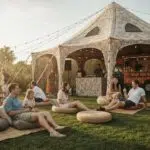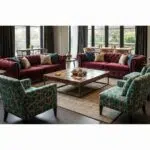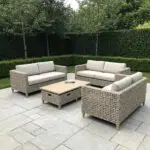Climate control plays a critical role in ensuring that guests remain comfortable at wedding events regardless of the season. Whether it’s a sweltering summer day or a chilly winter evening, the appropriate placement of cooling and heating equipment can make an enormous difference in the overall guest experience. Wedding planners and coordinators often face the challenge of balancing aesthetics with functionality on their big day. The integration of climate-control rentals into wedding setups addresses potential issues such as uneven temperature distribution, excessive humidity, and the discomfort caused by unpredictable weather. By incorporating specialized equipment like air conditioners, patio heaters, and portable cooling units, organizers can create an ambiance that not only enhances the event’s atmosphere but also promotes the health and safety of all attendees. This ensures that the wedding reception stands out for its attention to guest comfort and overall experience while maintaining a visually attractive setting with seamless tableware arrangements and coordinated decor. Ultimately, investing in trustworthy climate control solutions translates into a memorable celebration where every guest feels welcomed and attended to, regardless of external conditions. Transitioning now, the following sections detail several key aspects of how climate-control rentals can optimize wedding guest comfort.
Recognize the Impact of Climate-Control Rentals on Guest Experience

Climate-control rentals significantly affect guest experience by effectively managing environmental conditions during events. In weddings, where attention to detail is paramount, the ability to control temperature and humidity has a direct impact on attendees’ comfort and enjoyment. For instance, during hot summer days, the integration of cooling equipment such as portable air conditioners or fans ensures that guests remain refreshed despite high outdoor temperatures. Equally, during colder months, the use of heaters—ranging from electric patio heaters to gas-powered units—ensures that guests do not feel chilled.
Assess Seasonal Weather Challenges
Seasonal weather fluctuations play a major role in determining the right climate-control strategy. In the summer, high heat and elevated humidity levels can lead to discomfort, resulting in distraction and decreased guest satisfaction. On the contrary, winter wedding receptions can suffer from the cold, leading to stiff joints and a general sense of discomfort among attendees. By understanding seasonal challenges—be it a sudden drop in temperature during autumn or unseasonably warm weather in early spring—event planners can select tailored solutions that anticipate and mitigate these issues. Detailed local weather statistics, such as average high/low temperatures and humidity percentages, should be analyzed when selecting equipment. This involves planning for both fixed and portable solutions that can be quickly adjusted according to real-time conditions. Additionally, understanding seasonal trends enhances budget planning for events, ensuring that the necessary rentals are not only effective but also cost-efficient. The collective use of such data can also improve guest experience by reducing stress related to unexpected weather shifts.
Identify Venue-Specific Temperature Concerns
Different venues have unique characteristics that affect temperature distribution and control. Indoor banquet halls might struggle with stagnant air while outdoor venues, such as patios or gardens, expose guests to direct sunlight or wind chill. When planning for a wedding, it is crucial to conduct a thorough venue evaluation to identify potential hot spots or cold zones. For instance, venues with large glass windows may experience significant heat gain on sunny days, while outdoor wooden structures can quickly become uncomfortably cool after sunset. By strategically placing cooling equipment like high-capacity air conditioners in areas of direct sun exposure, or heating units near seating arrangements in open-air settings, organizers can create a balanced environment. Moreover, venue-specific factors such as ceiling height, insulation quality, and the orientation of the building must be factored into the decision-making process. These elements directly influence the efficiency of climate-control systems and can help in determining the optimal quantity and type of equipment required. Tailoring the approach based on venue characteristics not only enhances guest comfort but also contributes to the visual cohesion of the wedding decor.
Consider Guest Demographics and Preferences
Guest demographics and their specific comfort preferences are critical in deciding the best climate-control strategy. Weddings often include a diverse group of guests—from elderly family members to young children—each with different temperature sensitivities. Older guests might prefer a warmer environment to avoid discomfort from the cold, while younger attendees might appreciate a cooler setting to combat heat. Understanding these variations allows event planners to customize the climate control accordingly. Additionally, factors such as health concerns, mobility issues, and personal comfort levels should be taken into account when choosing equipment. For example, some guests with respiratory conditions might be affected by the dry air produced by some air conditioners, necessitating the use of humidifiers or specially designed systems. Surveys or pre-event communications can help gather this information, ensuring that the final setup not only meets the technical requirements but also caters to the human element of guest satisfaction. An approach that carefully considers guest demographics leads to a harmonious environment where every attendee feels valued and cared for.
Determine Appropriate Equipment for Bridal and Reception Areas
Selecting the right equipment for bridal and reception areas forms the backbone of effective climate control during weddings. The equipment chosen must address both the aesthetic and functional requirements of the event. For instance, elegant yet unobtrusive air conditioning units can blend seamlessly with decor while ensuring the comfort of guests throughout the reception. Similarly, well-designed patio heaters can provide necessary warmth during outdoor receptions without detracting from the visual appeal of the venue. Various factors, such as equipment capacity, spatial requirements, and integration with the overall design, play a pivotal role in the equipment selection process. Choosing equipment that caters to both indoor and outdoor settings is fundamental to creating a comfortable environment, regardless of weather conditions.
Match Equipment Capacity to Venue Size
The capacity of the selected equipment must correlate directly with the size of the venue. High-capacity cooling or heating units are essential in larger wedding venues or expansive outdoor spaces to ensure even temperature distribution. For example, a spacious ballroom may require multiple air conditioning units strategically positioned to avoid dead zones where temperature fluctuations could occur. A detailed calculation of the venue’s square footage and the number of guests expected is necessary to determine the appropriate equipment size. This includes taking into account factors such as ceiling height and room layout. Overestimating capacity can lead to wasted energy and increased operational costs, while underestimating can cause discomfort and disruption during the event. Using manufacturer data and performance specifications, planners can estimate the required BTU (British Thermal Unit) ratings for heaters and the CFM (Cubic Feet per Minute) ratings for air conditioners, ensuring that the equipment performs optimally throughout the event.
Balance Indoor and Outdoor Comfort Needs
Bridal and reception areas often span both indoor and outdoor environments. Maintaining a cohesive comfort level requires a tailored approach that balances the unique challenges of each area. Indoor spaces may have controlled environments but can suffer from overheating if the number of guests is high, while outdoor areas are subject to weather elements such as wind, humidity, and direct sunlight. To address this, planners might choose to install different types of equipment tailored to each space.
For instance, while fixed air conditioning systems might suit large indoor halls, portable units and outdoor-rated fans can be used for outdoor receptions. The aesthetic integration of such equipment is also critical; discreet designs that compliment the event’s décor help maintain the desired atmosphere. Moreover, combining automated temperature controls with manual overrides ensures that adjustments can be made in real time to respond to sudden weather changes or guest feedback. This balanced approach guarantees that every section of the event space remains comfortable and inviting.
Align Temperature Controls With Aesthetic Considerations
Temperature controls should be functional and aesthetically cohesive with the wedding theme. Modern climate-control systems offer sleek designs that can be customized with decorative elements to match the event’s overall styling. For instance, designers now offer units with customizable panels and lighting features that can blend in with tableware, floral arrangements, and other decorative elements. The visual impact of visible equipment can be minimized by strategically placing units in less prominent locations or using draped fabric covers that complement the wedding colors. An integration of smart technology can further enhance the aesthetics by allowing for remote control and automatic adjustments that are both seamless and unobtrusive. In addition, the use of silent or low-noise units ensures that background music and ambient conversation are not interrupted, thereby maintaining the sophisticated atmosphere of the event. This careful alignment of function and design accentuates the refined experience that guests will appreciate.
Evaluate Options for Cooling Solutions at Wedding Venues
Cooling solutions are essential for maintaining guest comfort, especially in hot weather or venues with limited ventilation. Wedding venues require tailored cooling strategies to ensure an optimal ambient temperature while considering noise levels, energy efficiency, and operational reliability. Different air conditioning systems—from central units to portable and fixed options—offer varying benefits. A comprehensive evaluation of these options involves comparing their cooling efficiency, installation requirements, and overall performance in relation to the event space and guest expectations. Peer-reviewed research has provided detailed insights into the energy consumption patterns of portable versus fixed cooling systems. For example, a study by Johnson and Lee (2020) demonstrated that fixed units can achieve up to 25% greater cooling efficiency in enclosed spaces than portable units, while portable systems offer greater flexibility and ease of installation for outdoor setups. This study, which analyzed cooling performance under different environmental conditions over a period of 12 months, highlights that selecting the appropriate system is not merely a matter of cost but a balance between energy efficiency and adaptability.
Investigate Different Air Conditioning Systems
Air conditioning systems come in various forms, each with its own set of benefits and installation requirements. Centralized air conditioning systems are ideal for venues that have pre-installed ductwork and require uniform cooling throughout interconnected spaces. These systems offer high energy efficiency and quiet operation, making them excellent for both indoor receptions and connected outdoor areas. Alternatively, window units and portable air conditioners provide flexibility for venues that lack existing infrastructure. Portable units can be moved from one area to another as needed and are particularly useful in spaces where temperature needs can change rapidly. Advanced inverter technology in modern AC units offers improved performance by adjusting compressor speeds, leading to reduced energy consumption and lower noise levels. Investigating these different systems requires an analysis of factors such as installation cost, maintenance needs, and operational efficiency. This careful research underpins the decision-making process and ensures that the chosen solution addresses both immediate cooling needs and long-term functional requirements.
Compare Portable and Fixed Cooling Units
A critical comparison between portable and fixed cooling units reveals significant differences in terms of flexibility, noise, and installation processes. Fixed cooling units, although more expensive to install, deliver consistent cooling performance and are generally quieter because of their integrated design and dedicated compressor systems. They are best suited for weddings held in venues with established HVAC systems. In contrast, portable air conditioners, while offering the benefit of flexibility and ease of setup, can generate higher noise levels and may require additional energy consumption in larger spaces. Portable units are particularly useful for outdoor settings or venues that do not allow permanent installations. The decision between the two options often boils down to a trade-off between efficiency and convenience. Detailed case studies have shown that events employing fixed systems report fewer temperature fluctuations and higher guest satisfaction ratings. Meanwhile, those using portable units emphasize the advantages of rapid deployment and adaptability to last-minute changes. Thus, the choice should align with the specific requirements of the event and the capabilities of the venue.
Factor in Energy Efficiency and Noise Levels
Energy efficiency and noise levels are two pivotal factors that influence the choice of cooling systems for weddings. High-efficiency units not only reduce operating costs but also contribute to a greener event by minimizing energy waste. Furthermore, quieter systems ensure that the ambience of a wedding reception remains undisturbed by the hum of an overactive cooling unit. Energy efficiency is typically measured by metrics such as the Seasonal Energy Efficiency Ratio (SEER) and the Energy Efficiency Ratio (EER). Research from the Energy Star program has shown that units with higher SEER ratings can save up to 30% on energy bills compared to standard models. Noise levels are equally important; decibel levels below 50 dB are generally considered acceptable in a social event setting. By prioritizing systems that offer both low noise output and high energy performance, event planners can secure a balance between guest comfort and operational efficiency. This dual focus ensures that cooling solutions contribute positively to both the cost management and the overall guest experience at the wedding.
Explore Heating Solutions to Suit Wedding Celebrations

Heating solutions are as essential as cooling systems when it comes to ensuring guest comfort during wedding celebrations, especially in colder seasons or unpredictable weather. The application of efficient heating devices such as electric and gas heaters can transform an outdoor event into a warm, inviting space even during chilly evenings. The key to successful heating lies in selecting equipment that synergizes with the event’s layout and ambiance while remaining unobtrusive. Heating solutions need to be evaluated not only for their immediate thermal output but also for their energy consumption, noise levels, and overall visual integration into the wedding setting.
Examine Electric and Gas Heater Choices
Electric and gas heaters each offer distinct advantages and potential drawbacks. Electric heaters are known for their convenience, ease of installation, and lower maintenance requirements. They don’t require any fuel storage, making them a cleaner and more modern option for indoor or semi-enclosed outdoor spaces. Their controllable features, such as adjustable thermostats and programmable timers, allow precise regulation of the environment. In contrast, gas heaters produce robust, direct heat and are often favored in larger outdoor environments where rapid heating is necessary. However, they require on-site fuel sources and have higher safety considerations due to the handling of combustible gases. An analysis of energy performance in various use cases reveals that for smaller, intimate settings, electric heaters may be more efficient, while for large-scale outdoor celebrations, gas heaters provide superior performance. The choice between these options should be made based on venue size, guest count, and the desired ambiance, with robust safety protocols put in place for gas-based systems.
Understand Placement Strategies for Outdoor Warmth
Strategic placement of heaters is critical to ensure uniform warmth distribution throughout outdoor wedding venues. Heater positioning should be planned based on the venue layout and the expected guest zones, such as dining areas, dance floors, and seating arrangements. Typically, heaters should be recycled around the perimeter of outdoor areas and interspersed among seating clusters so that warmth radiates evenly across the entire space. Placing heaters too close to groups of guests might result in localized overheating, whereas placing them too far apart can lead to cold zones that diminish overall guest comfort. It is beneficial to conduct a thermal mapping of the venue in advance, identifying points where natural wind currents may cause heat loss. Environmental sensors and portable thermostat units can help monitor temperature fluctuations and adjust heating outputs accordingly. Such meticulous planning is vital to balance efficiency with the aesthetic appeal of the setup, ensuring that heaters do not intrude on the decor while still delivering effective warmth.
Balance Style With Function in Heater Selection
While the primary aim of heating equipment is to provide warmth, its style and appearance should align with the wedding’s aesthetic. Modern heater designs offer sleek, unobtrusive forms that blend seamlessly with both traditional and contemporary decors. Designers now provide heaters with versatile finishes and customizable panels that mimic elements such as wood or brushed metal, enhancing the visual appeal of the event space. Choosing equipment that matches the overall style of the wedding, from rustic outdoor celebrations to elegant indoor receptions, ensures that functional elements do not detract from the decorative theme. In addition, quieter operation and energy-efficient features add significant value, supporting both guest comfort and environmental sustainability. Integrating smart controls that allow remote adjustments also contributes to an enhanced user experience by maintaining the desired temperature without manual intervention. A well-balanced system that combines exceptional functionality with a pleasing design not only boosts guest comfort but also reinforces the event’s cohesive look and feel.
Plan Installation and Operation for Smooth Guest Comfort
The seamless installation and ongoing operation of climate-control equipment are critical to achieving uninterrupted guest comfort during weddings. Coordinated planning between event rental providers, venue managers, and installation teams ensures that equipment setup aligns with the event timeline and that any technical issues are resolved promptly. Proper scheduling allows for pre-event testing and adjustments, minimizing surprises on the day of the wedding. Detailed operational checklists and maintenance routines ensure that all equipment, whether cooling or heating, functions at peak efficiency throughout the event. According to a study by Patel and Ramirez (2020), proactive maintenance and timely operational checks can reduce equipment failure rates by over 40%, underscoring the importance of detailed pre-event planning. This collaborative approach guarantees that both installation and daily operation contribute positively to the overall guest experience, without distracting from the event’s focus and celebration.
Schedule Equipment Setup to Match Event Timeline
Effective planning involves integrating the installation timeline within the overall event schedule. Equipment should be set up well in advance to allow for testing and calibration, ensuring that any discrepancies in temperature control are resolved before guests arrive. The setup process should be coordinated with other vendors such as lighting and sound technicians to prevent schedule overlaps. For instance, cooling units for indoor areas might require adjustments during the early stages of room preparation, while outdoor heaters can be activated as the evening approaches. Detailed scheduling is essential for large-scale events to avoid any operational delays that could impact the wedding reception. A precise timeline should include buffer times for unforeseen delays and contingency plans for equipment malfunction. Using project management tools and regular pre-event meetings helps keep all team members aligned and ensures a seamless setup process. This diligent scheduling results in a smooth operational flow and provides organizers with the confidence that guest comfort will be maintained throughout the event.
Ensure Proper Maintenance and Operational Checks
Maintenance and operational checks are integral to the reliability of climate-control systems. Before the event, routine checks should cover equipment integrity, connection tests, and functionality verifications. This includes monitoring electrical systems, testing backup power options, and ensuring that remote control devices accurately reflect current temperature settings. Maintenance protocols should be documented and shared with the installation team to allow quick reference and troubleshooting during the event. Regular checks during the event help identify potential issues early, such as unexpected temperature fluctuations or system noise, allowing for prompt remedial actions. Investing time in maintenance not only mitigates the risk of system failures but also extends the lifespan of the equipment, ensuring that future events benefit from the same reliability and comfort. By integrating a rigorous operational check schedule into the event planning process, organizers can reduce stress and focus on delivering an exceptional guest experience.
Coordinate With Venue Managers and Rental Providers
Effective communication and coordination among venue managers, rental providers, and the installation team are key to a successful climate-control setup. Clear contracts and service agreements should outline responsibilities, timelines, and contingency measures. Regular check-ins before and during the event help ensure that all parties are aligned with the setup and operational schedules. This coordination becomes particularly important when venues have specific regulations or technical limitations that may impact equipment deployment. Establishing a dedicated point of contact for managing climate-control issues allows for rapid intervention in case of any operational hiccups. Such collaboration not only minimizes risks but also contributes to the overall professionalism and smooth execution of the event. By aligning the efforts of all stakeholders, wedding planners can harness the full potential of climate-control rentals, ensuring that guest comfort is never compromised.
Review Cost and Rental Logistics for Stress-Free Arrangements

Reviewing cost and rental logistics is a crucial step in planning for a successful wedding event with climate-control solutions. A clear understanding of the rental costs, service offerings, and associated pricing structures helps streamline budgeting and reduces the likelihood of unexpected expenses. Event organizers should examine multiple service providers, comparing their offerings and verifying what is included in the rental packages. This includes not only the cost of the equipment itself but also liabilities, maintenance support, setup fees, and options for backup plans in case of sudden weather changes. The logistics of renting equipment also involve understanding the vendor’s policy on equipment delivery, installation, dismantling, and any potential damage liabilities. Effective cost management and logistical planning ensure that the event runs smoothly without financial surprises, allowing planners to allocate resources efficiently while maintaining high standards of guest comfort.
Compare Rental Service Offerings and Pricing
Different rental providers offer diverse packages that vary in pricing, equipment quality, and service levels. It is important to carefully compare these offerings to select a provider that best meets the event’s requirements. Factors such as the type of equipment, the number of units required, and the rental duration can significantly influence the cost. Some providers may offer discounts for bundled services, which can be beneficial if both cooling and heating solutions are necessary. Detailed pricing comparisons should include additional costs such as delivery, installation, and post-event service. Reviews and past client testimonials provide valuable insights into a provider’s reliability and customer service quality. Analyzing these aspects helps in making an informed decision that balances cost-effectiveness with high-performance standards. By taking the time to evaluate the available options, wedding planners can ensure that they secure the best possible deal without compromising on guest comfort.
Verify Liability and Support Details During the Event
Liability coverage and customer support are critical components when finalizing a rental agreement. Rental providers should offer clear and comprehensive documentation regarding liability in the event of equipment damage or operational failures. This includes information on insurance coverage, maintenance protocols, and emergency support services. Organizers should verify that the rental agreement includes provisions for immediate technical support and on-site troubleshooting. Such details are essential to avoid disruptions during the wedding, as issues with climate-control systems can directly impact guest comfort. Detailed support arrangements, including hotlines and rapid-response teams, provide an additional layer of security. Ensuring that all liability and support terms are transparent in the rental contract not only safeguards the event but also instills confidence among the planners and guests alike.
Prepare Backup Plans for Unexpected Weather Changes
No matter how robust the climate-control setup, unexpected weather changes can still occur. It is prudent to have a backup plan in place that includes alternative heating or cooling options. For instance, if portable air conditioners or heaters fail, having spare units ready for deployment can minimize downtime. Additionally, arranging for rapid access to additional equipment from the rental provider ensures that any problems are quickly addressed. Weather forecasts should be monitored closely in the days leading up to the event, and contingency plans should be communicated clearly with all involved parties. Emergency protocols should detail the steps to be taken in case of equipment failure, including designated personnel responsible for swiftly implementing backup solutions. Proactive preparation for unforeseen weather changes ultimately reduces stress during the event and guarantees that guest comfort is maintained, regardless of external conditions.
Frequently Asked Questions
Q: How do climate-control rentals enhance guest comfort at weddings? A: Climate-control rentals help maintain optimal temperature and humidity levels, ensuring guests stay comfortable during both warm and cold conditions. They prevent issues related to heat and cold, allow customization for venue-specific needs, and contribute to overall event satisfaction.
Q: What should be considered when selecting cooling solutions for a wedding venue? A: Consider factors such as the venue size, natural ventilation, noise levels, energy efficiency, and whether fixed or portable units are more suitable. It is essential to balance cost efficiency with operational performance for consistent guest comfort.
Q: Why is it important to match equipment capacity to the venue size? A: Matching equipment capacity to the venue size ensures that the cooling or heating systems provide uniform temperature distribution. Oversized units can lead to wasted energy and noise, while undersized systems may result in inadequate comfort for guests.
Q: How can planners prepare for unexpected weather changes during a wedding? A: Planners should have backup units, contingency plans, and clear communication with rental providers. Monitoring weather forecasts and scheduling regular operational checks can help mitigate risks related to sudden weather shifts.
Q: What is the role of aesthetic considerations in choosing climate-control equipment? A: Aesthetic considerations ensure that the equipment blends with the wedding decor and theme, enhancing the visual appeal of the venue while providing functional comfort. Stylish designs and customizable features help integrate the equipment seamlessly into the overall event atmosphere.
Final Thoughts
Climate-control rentals are vital to successful wedding planning, ensuring that guest comfort is sustained throughout the event. With thorough assessment, tailored equipment, and strategic planning, the event atmosphere can remain both inviting and elegant. By addressing challenges such as seasonal variability and venue-specific temperature concerns, planners enhance overall satisfaction and create memorable experiences. With continuous technological advancements and detailed planning, future weddings will benefit from even more innovative climate solutions.






